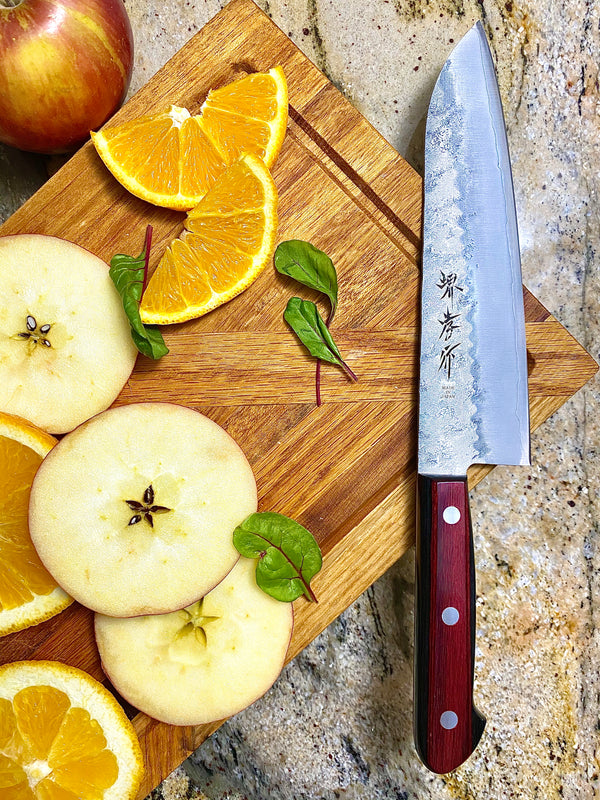Your Cart is Empty
There’s little that compares to the feel of a traditional Japanese knife in your hand. Each piece is handmade by an accomplished craftsman — the result of hours of labor and skills that have taken decades to master. Their beautiful handles are often fashioned from polished wood, such as maple or white-bark magnolia, and each handle is carefully designed with the knife’s purpose in mind. Its blade is likewise purpose-built for certain tasks, making short work of meats and produce alike.
Below are some of our best-selling knife designs. Explore our entire selection if you don’t find what you’re looking for here.
There’s little that compares to the feel of a traditional Japanese knife in your hand. Each piece is handmade by an accomplished craftsman — the result of hours of labor and skills that have taken decades to master. Their beautiful handles are often fashioned from. . . Show More >
There’s little that compares to the feel of a traditional Japanese knife in your hand. Each piece is handmade by an accomplished craftsman — the result of hours of labor and skills that have taken decades to master. Their beautiful handles are often fashioned from polished wood, such as maple or white-bark magnolia, and each handle is carefully designed with the knife’s purpose in mind. Its blade is likewise purpose-built for certain tasks, making short work of meats and produce alike.
Below are some of our best-selling knife designs. Explore our entire selection if you don’t find what you’re looking for here.
< Show LessNo products found in this collection
Traditional Japanese kitchen knives are mostly designed for specific tasks.
For example, the Nakiri and Usuba are vegetable knives which can be used on a variety of produce. They’re the knives of choice for Japanese chefs to execute specialized cutting techniques, such as Kazarigiri (“decorative cutting”) and Katsuramuki (“rotary peeling”).
A Deba is the perfect butchery knife, while a Yanagiba is the go-to for a Japanese sushi chef. A Petty knife will help you breeze through the smaller prep work in your kitchen. If you’re looking for an all-purpose chef’s knife, there’s nothing better than a Gyuto or Santoku for your collection.
Browse through our Knife Buying Guide for more information on the advantages of various Japanese knives, or if you need help, simply reach out to us.
The art of knifemaking in Japan goes back to the Sengoku period (1467-1568 CE) and is the descendant craft of renowned Japanese swordsmiths.
Traditional Japanese knives are prized by chefs worldwide for their quality, precision, and durability. They are forged using high-quality materials using intricate techniques that deliver exquisite results. Knifemaking is a proud tradition for bladesmiths and artisans in Japan. Our collection is sourced from some of the finest knifemakers across the country, including Misuzu Hamono from Miki, Kaneshige Hamono and Doi Knives from Sakai, Isamitsu from Ibaraki Prefecture, Sawakazuma in Echizen, as well as our family-owned company Sakai Takayuki, also from Sakai.
Find designs from all of these brands and more at Hasu-Seizo.
With the right care, your knife can last you a lifetime and become a treasured family heirloom that you can pass onto future generations.
With traditional Japanese knives, especially high-carbon ones, you should minimize their contact with moisture to help prevent rust and corrosion. When cleaning them, hand-wash them with warm water and dry with a soft tea towel. Make sure you wipe down your knife immediately after use and store it in a dry environment. Regularly applying Tsubaki Camellia Oil will also help to maintain your knife.
In order to preserve the edge, particularly with your single-bevel knives, it is essential to periodically sharpen your blade with a whetstone. It will give you much better results than if you use an electric sharpener or a honing rod. Learn more about taking care of your traditional Japanese knife in our Knife Maintenance Guide.

Subscribe to get 10% off your first order in addition to our monthly newsletter which gets you first dibs on newly arrived knives, custom designs, and special offers. Discount can not be combined with other seasonal discounts.